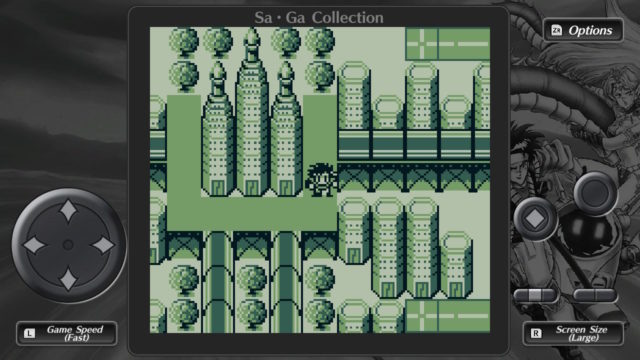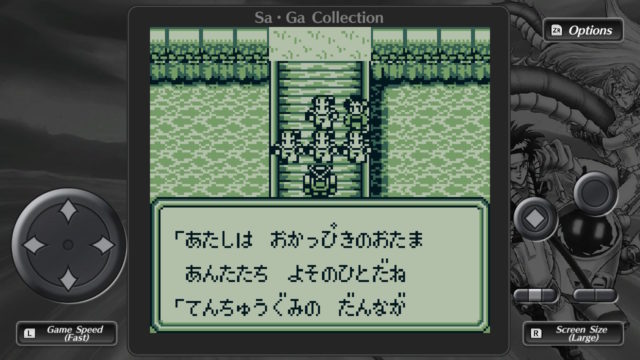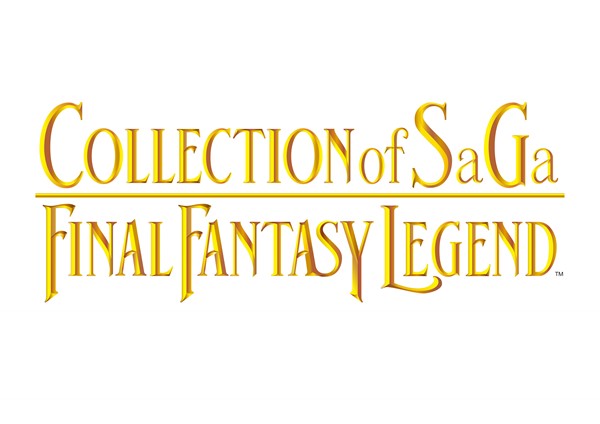Collection of SaGa Final Fantasy Legend (Part 2) Review
The Goddess of Destiny
Note: This review is part two of three. Read part one here.
Originally released on the Game Boy in 1990, Final Fantasy Legend II — or SaGa 2: Hihou no Densetsu as it’s known in Japan — was and still is my favourite Game Boy game of all time. It improves on its predecessor in every single aspect, especially in the story department where the main character adventures out to find his long-lost father. Having lost my father at a young age, this game resonated with me during my childhood as I easily identified with the main character. So I sallied forth into the colourless world to find my father, and met a memorable, albeit simple cast of characters along the way. And when it was all over, I had an epic adventure, a satisfying ending, and the classic chiptunes stuck in my head. Now released as part of the Collection of SaGa Final Fantasy Legend on the Nintendo Switch, this classic Game Boy RPG is once again accessible to new players, along with some new features to boot.
Final Fantasy Legend II opens with a simple, but great, hook for an RPG. The protagonist is awoken in the middle of the night by his Dad, who leaves behind a mysterious object called a Magi and tells him to keep it safe, before disappearing and never coming back. Years later, the protagonist promises Mom that he will find Dad and ventures out to look for him. He discovers that the Magi is just one of 76 needed to make the statue of the goddess, Isis, and that Dad was protecting Magi against those who seek to collect and abuse its power. Thus, the story focuses around these two objectives: finding Dad and collecting other Magi.
Next, the player creates a party composed of humans, mutants, robots, or monsters, including choosing the gender for any humans or mutants. As with its predecessor, players can create any combination, such as choosing all mutants or all robots. Humans and mutants have randomised stat growths, meaning such characters may end up with significantly different attributes in subsequent playthroughs. Once again, this freedom of creating a party drastically shifts the gameplay, giving the game quite the replay value for a linear RPG.
This time around, the classes are more balanced, each with advantages and disadvantages, though monsters still trail behind the others. Now players can also choose robots, whose stats are based entirely on what they have equipped, making them easily upgradable but quite expensive. Humans and mutants raise stats based on what they use in battle; for example, using magic raises mana and using a strength-based sword raises strength. Mutants can still learn up to four different abilities randomly, but this time, only the bottom ability gets replaced when using a new one. Monsters, if evolved correctly, have a lot more punch in this game compared to the predecessor, and since they rely on monster meat to evolve, they require no grinding or equipment to raise stats. Yet, most monster transformations tend to lag behind the rest of the other races in terms of stats, still leaving them as the weaker choice.
The combat system is the standard, turn-based affair, but with a few changes. Weapons and spellbooks, which humans rely on, will run out after a limited number of uses and will need to be replaced. Mutants and monsters have abilities that also have a limited number of uses, but they can be recharged upon resting at an inn; this also applies to any item equipped on a robot, though equipping or unequipping gear on them halves its maximum number of uses. The item menu doesn’t allow the party to carry many items either, and players will waste time deciding which items are necessary to keep or toss out during the long dungeon treks.
The battle system can be quite unfair at times, as players will often encounter many enemies, sometimes reaching double-figures. A surprise attack of such kind can cripple even the most-prepared adventurers, and the excruciatingly high encounter rate compounds this problem during dungeons, making them much longer than necessary. This also exacerbates the item management problem, because even a powerful party can face the risk of running out of weapons after facing waves upon waves of enemies. Fortunately, players can easily run away from most fights and the double-speed feature in this edition cuts down on the grinding and prolonged battles.
The setting of Final Fantasy Legend II is much larger than its predecessor. There are many worlds, which are connected by pillars that can only be traversed if the player collects enough Magi in order to pass through; ironically, NPCs and villains aren’t restricted by this rule one bit. As players venture further through the game, they will encounter people who know Dad or learn more about Magi. The story beats are simple, yet fun, though there is very little in character development besides the relationship between the main character and Dad.
The graphics improve from the first game, as there are a larger variety of NPC sprites and most of the towns look unique enough, especially Venus’s City, which is complete with high-rise towers and escalators. The monsters look well-designed and detailed despite the limit of four shades, and the bosses look interesting and memorable enough, as they are based off of gods like Ashura, Odin, and Venus. Despite the improvements, this was still an early Game Boy game, so the sprite graphics are still repetitive compared to the console’s later releases.

Many towns look different, though there isn’t much to explore beyond the simple story beat and shops.
The soundtrack, which is composed by Nobuo Uematsu, boasts more tracks than the previous game and is the best-sounding of the trio of titles in the collection. “The Legend Begins” reprises its opening role, and there are many powerhouse tracks like “Burning Blood”, “Hero Theme”, “Dreadful Fight”, “Mother Earth”, etc. These tracks rival the quality of the composer’s Final Fantasy compositions, and it’s a shame they don’t enjoy the same notoriety. The sound effects are minimal and in no way obtrusive, letting the music stand out more. The only drawback to the music would be the repetitiveness of it, but that’s more due to hardware limitations of the time rather than the game itself.
The modern localisation has changed a few things to the text in a few interesting ways, as evident in the message before the title screen that reads: “several changes have been made to meet evolving cultural and social norms”. The script is still based on the original release, but some items and creatures have been renamed to address copyright and trademark issues, such as the ‘Colt’ gun now being called ‘Pistol’. Other changes, mainly to the script, feel a bit unnecessary, even to the point of sounding awkward. For one, an enemy called Terrorist is renamed Partisan, though the Japanese version retains the Terrorist label. In another instance, a character who introduced herself perfectly understandably as a detective in the original localised version, now uses the archaic term flatfoot to no discernable benefit. As other villagers and the status screen still refer to her as a detective, the new wording in that spot just sounds out of place.

Unlike the English version, the Japanese script, apart from copyright terms, has remained largely unchanged from the original.
Despite these modern changes to the script, the censorship, parts with poor translation, and omissions from the initial localisation remain. For instance, bananas — as opposed to opium in the Japanese version — are still being smuggled in Edo. In one particular scene, the protagonist remonstrates a specific NPC for having an affair in the Japanese version, but the practices of the ’90s saw several crucial lines of dialogue removed from the English version that diminish the emotional impact of later events. This anniversary collection was a great opportunity to correct this part of the game, but alas, the protagonist’s emotional bits of dialogue are still missing. Even though they do not affect the overall quality of the game, it would have been nice if the censored script had been updated, at least.
Back during its initial release, Final Fantasy Legend II was one of the best RPGs on the Game Boy. It still stands the test of time today, though a fair share of flaws has come with age. The story doesn’t seem quite as epic any more, and the high encounter rate brings more frustration than fun at times. Despite these flaws, the combat system and the party creation are still fun to play around with, and going out to find Dad still brought me the same touching charm it did 30 years ago. And best of all, the quality-of-life additions, such as the double speed feature, really make this game much more playable. It leaves the collection as an ideal place for players to revisit or learn about this classic.
Disclosure: This review is based on a free copy of the game provided by the publisher.


QOL improve game pacing
Memorable soundtrack by Nobuo Uematsu
Simplistic, yet charming story
Variety of party creation options
Extremely high random encounter rate
Poor inventory UI
Some unnecessary modern localisation changes
Many monster transformations are useless








If you ever have the chance to play the DS remake, go for it. You would absolutely love the experience.
I own it, along with the remake for SaGa 3. 🙂 I love them. I also like the party chat feature they added in, which fleshes out the party members a bit more. I may review it here one day.